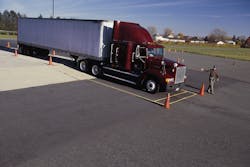Setting a minimum number of hours for behind-the-wheel (BTW) practice remains a sticking point in the long-awaited proposal to set federal standards for truck driver training, based on comments submitted ahead of last week’s deadline.
The American Trucking Assns. (ATA) continues to voice its opposition to the BTW requirement, as set in the Notice of Proposed Rulemaking published March 7.
“ATA strongly opposes a mandatory minimum number of hours spent in BTW training. Instead, ATA encourages the agency to pursue a pure competency-based final rule that relies on verification of demonstrated skills and techniques to ensure that drivers are prepared to operate commercial motor vehicles (CMVs) safely,” ATA writes.
Among the reasons for the opposition, ATA argues that:
- research does not indicate a relationship between the number of hours spent in training and a reduction in crashes
- the hours-based proposal contravenes a federal directive to specify “performance objectives” rather than how those objectives are to be achieved
- carrier training experience demonstrates that more hours trained BTW does not correlate with a reduction in future crash risk; and
- the assignment of a minimum 30 hours BTW training is an arbitrary political compromise, essentially “splitting the difference” between the low and high ranges suggested during the negotiation on the proposed rule.
ATA was one of 26 members of the Entry-Level Driver Training Advisory Committee (ELDTAC) which developed the proposal last year, but the training minimum was supported by 24 of the other committee members, enough to include the requirement under the negotiated rulemaking procedures.
The Associated General Contractors of America (AGCA) also opposes the BTW time requirement, stating in its filing that the requirement has the potential to make the available CDL driver supply “even tighter” for the construction industry.
“Many construction firms operate in-house training initiatives to ensure that their drivers are thoroughly familiar with safe driving practices and are well-versed in the specific requirements of driving construction industry vehicles,” AGCA writes. “Industry experience indicates that performance-based training provides the best way to train drivers to the nuances of the industry.”
A number of agricultural interests voiced similar concerns, as did several large trucking companies who operate training schools or have extensive “finishing” programs in place.
But the Truckload Carriers Assn. (TCA) suggested the BTW requirement is the “least cumbersome” compromise.
“Considering the lack of a certified, professional workforce to oversee any complex training programs, the establishment of hours in measuring BTW time represented the most uncomplicated way in which one could track the driving skills of entry-level drivers,” TCA writes.
“In the opinion of those in who served on the ELDTAC, the requirements put forward are agreeable and the ELDTAC, through the participants’ hundreds of years of collective experience in training, safety, trucking, bus, and insurance sectors, agreed that demonstrated performance of those BTW skills, as outlined in the NPRM, combined with a minimum BTW time is the proper approach,” CVTA writes. “Since the majority of ELDTAC participants agreed to performance with no less 30 hours of BTW time, we believe that this opinion improves safety, and is a logical and reasonable interpretation of the enabling statute.”
Advocates for Highway and Auto Safety, who had a representative on the standards committee, also supports the proposal.
“Requiring that applicants are given a standardized curriculum that includes a minimum number of hours of BTW training is sensible approach to ensure that new drivers obtain certain skills that can only be learned while actually operating a CMV,” the safety advocacy group writes.
The Owner-Operator Independent Drivers Association has long pushed for training standards, and supports the 30-hour minimum as one of the elements of the proposal that “would likely improve safety.”
“The minimum 30-hours of BTW time is an immense improvement over the current standard, which is zero hours,” OOIDA writes. “This required BTW training provides greater opportunity to evaluate the skills of the entry-level driver and for the trainer to offer corrective actions as compared to the brief evaluation that the examiner is able to presently conduct.”
OOIDA does take issue, however, with the proposed “refresher” training requirements for drivers who have been disqualified, particularly with the “one-size-fits-all” retraining “regardless of the underlying disqualifying offense.”
“There is a disconnect between disqualification and the content of refresher courses,” OOIDA says. “Many of these violations listed for disqualification could easily be due to momentary lapses in judgment and/or unintended consequences due to being in unfamiliar situations, neither of which would be corrected through additional financial and time penalties.”




